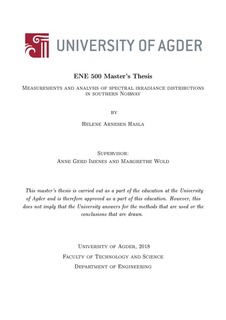| dc.description.abstract | The spectral response of the photovoltaic (PV) cell depends on which technology that is used and
the outdoor performance of PV modules depends on solar irradiation, module temperature, and solar
spectrum. Therefore, di erent locations should give di erent PV performance outcome. This thesis
investigates local spectral irradiance measurements, which will be analysed to document irradiance
conditions, and give an indication of which PV technology to prefer in Southern Norway.
A spectroradiometer is calibrated for use to measure the spectral irradiance at the University of Agder
in Grimstad. From February to April in 2018, spectral irradiance data were collected. These data
are used to analyse the spectral irradiance distribution during the months. Moreover, with the Simple
Model for the Atmospheric Radiative Transfer of Sunshine version (SMARTS) and data from the
nearby air station, di erent atmospheric parameters are analysed to test their in uence on the spectra.
A literature review of the Average Photon Energy (APE) presented, and APE is used further to
characterize the spectral irradiance. APE from this thesis work is from 1:95 2:1 eV. The APE value
is used to determine if the spectra are classi ed as blue rich or red rich. APE values from May and
April are blue rich, while in February the majority of APE values are red rich.
In addition to analysing the atmospheric parameter with SMARTS, a model for a clear sky for each
month is made. From the spectral irradiance measurements with a spectrometer, only the spectral
irradiance from 300 to 900 nm in uenced by noise. A model made in SMARTS gives the opportunity
to get the complete spectrum.
Spectral response (SR) curves for a-Si, c-Si, CIGS, and CdTe PV modules is used to calculate their
short circuit current density with both the measured data and the SMARTS models. The maximum
power output is also calculated with the SMARTS models. The results show that CIGS gives best PV
performance. However, the results for CIGS and c-Si is close and are both suitable PV technologies to
use for the Southern Norway conditions. | nb_NO |

